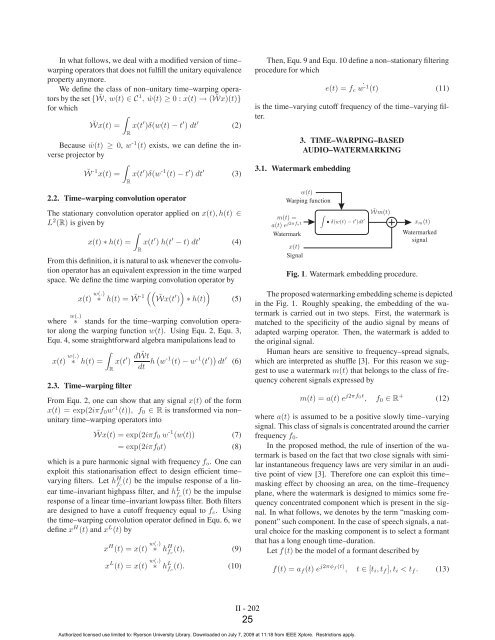Signal Analysis Research (SAR) Group - RNet - Ryerson University
Signal Analysis Research (SAR) Group - RNet - Ryerson University
Signal Analysis Research (SAR) Group - RNet - Ryerson University
You also want an ePaper? Increase the reach of your titles
YUMPU automatically turns print PDFs into web optimized ePapers that Google loves.
In what follows, we deal with a modied version of time–<br />
warping operators that does not fulll the unitary equivalence<br />
property anymore.<br />
We dene the class of non–unitary time–warping operators<br />
by the set { ˘ W,w(t) ∈C1 , ˙w(t) ≥ 0:x(t) → ( ˘ Wx)(t)}<br />
for which<br />
<br />
˘Wx(t) = x(t ′ )δ(w(t) − t ′ ) dt ′<br />
(2)<br />
R<br />
Because ˙w(t) ≥ 0, w-1 (t) exists, we can dene the inverse<br />
projector by<br />
˘W -1 <br />
x(t) = x(t ′ )δ(w -1 (t) − t ′ ) dt ′<br />
(3)<br />
2.2. Time–warping convolution operator<br />
R<br />
The stationary convolution operator applied on x(t),h(t) ∈<br />
L2 (R) is given by<br />
<br />
x(t) ∗ h(t) = x(t ′ ) h(t ′ − t) dt ′<br />
(4)<br />
R<br />
From this denition, it is natural to ask whenever the convolution<br />
operator has an equivalent expression in the time warped<br />
space. We dene the time warping convolution operator by<br />
x(t) w(.)<br />
∗ h(t) = ˘ W -1 <br />
Wx(t ˘ ′<br />
) ∗ h(t) (5)<br />
where w(.)<br />
∗ stands for the time–warping convolution operator<br />
along the warping function w(t). Using Equ. 2, Equ. 3,<br />
Equ. 4, some straightforward algebra manipulations lead to<br />
x(t) w(.)<br />
∗ h(t) =<br />
<br />
2.3. Time–warping lter<br />
R<br />
x(t ′ ) d ˘ Wt<br />
dt h w -1 (t) − w -1 (t ′ ) dt ′<br />
From Equ. 2, one can show that any signal x(t) of the form<br />
x(t) =exp(2iπf0w-1 (t)), f0∈ R is transformed via non–<br />
unitary time–warping operators into<br />
˘Wx(t) =exp(2iπf0 w -1 (w(t)) (7)<br />
=exp(2iπf0t) (8)<br />
which is a pure harmonic signal with frequency fo. One can<br />
exploit this stationarisation effect to design efcient time–<br />
varying lters. Let hH (t) be the impulse response of a lin-<br />
fc<br />
ear time–invariant highpass lter, and hL (t) be the impulse<br />
fc<br />
response of a linear time–invariant lowpass lter. Both lters<br />
are designed to have a cutoff frequency equal to fc. Using<br />
the time–warping convolution operator dened in Equ. 6, we<br />
dene x H (t) and x L (t) by<br />
(6)<br />
x H (t) =x(t) w(.)<br />
∗ h H (t), fc (9)<br />
x L (t) =x(t) w(.)<br />
∗ h L fc (t). (10)<br />
II 202<br />
25<br />
Then, Equ. 9 and Equ. 10 dene a non–stationary ltering<br />
procedure for which<br />
e(t) =fc<br />
˙<br />
w -1 (t) (11)<br />
is the time–varying cutoff frequency of the time–varying lter.<br />
3. TIME–WARPING–BASED<br />
AUDIO–WATERMARKING<br />
3.1. Watermark embedding<br />
w(t)<br />
Warping function<br />
m(t) =<br />
a(t) e<br />
x(t)<br />
j2πfot<br />
Watermark<br />
<strong>Signal</strong><br />
<br />
˘Wm(t)<br />
• δ(w(t) − t ′ )dt ′ xm(t)<br />
Fig. 1. Watermark embedding procedure.<br />
Watermarked<br />
signal<br />
The proposed watermarking embedding scheme is depicted<br />
in the Fig. 1. Roughly speaking, the embedding of the watermark<br />
is carried out in two steps. First, the watermark is<br />
matched to the specicity of the audio signal by means of<br />
adapted warping operator. Then, the watermark is added to<br />
the original signal.<br />
Human hears are sensitive to frequency–spread signals,<br />
which are interpreted as shufe [3]. For this reason we suggest<br />
to use a watermark m(t) that belongs to the class of frequency<br />
coherent signals expressed by<br />
m(t) =a(t) e j2πf0t , f0 ∈ R +<br />
(12)<br />
where a(t) is assumed to be a positive slowly time–varying<br />
signal. This class of signals is concentrated around the carrier<br />
frequency f0.<br />
In the proposed method, the rule of insertion of the watermark<br />
is based on the fact that two close signals with similar<br />
instantaneous frequency laws are very similar in an auditive<br />
point of view [3]. Therefore one can exploit this time–<br />
masking effect by choosing an area, on the time–frequency<br />
plane, where the watermark is designed to mimics some frequency<br />
concentrated component which is present in the signal.<br />
In what follows, we denotes by the term “masking component”<br />
such component. In the case of speech signals, a natural<br />
choice for the masking component is to select a formant<br />
that has a long enough time–duration.<br />
Let f(t) be the model of a formant described by<br />
Authorized licensed use limited to: <strong>Ryerson</strong> <strong>University</strong> Library. Downloaded on July 7, 2009 at 11:18 from IEEE Xplore. Restrictions apply.<br />
f(t) =af(t) e j2πφf (t) , t ∈ [ti,tf ],ti


